Long-Term Trends and Ecological Risks of Heavy Metal Accumulation in Cultivated Land of Songnen Plain, China
Abstract
:1. Introduction
2. Materials and Methods
2.1. Study Area
2.2. Sample Collection and Analysis
2.3. Quality Assurance and Quality Control
2.4. Heavy Metal Pollution Analysis
2.4.1. Geo-Accumulation Indicator ()
2.4.2. Single Pollution Index
2.5. Ecological Risk Assessment of Heavy Metals
2.6. Temporal Dynamic Trends of Heavy Metals in Soil
2.6.1. Dynamic Source Release Modeling
2.6.2. Temporal Dynamic Trends in Heavy Metal Accumulation
2.7. Statistical Analysis
3. Results and Discussion
3.1. Descriptive Statistics of Heavy Metal Content in Soil
| Parameter | Minimum | Maximum | Median | Mean | SD | CV | BV a | RSV b |
|---|---|---|---|---|---|---|---|---|
| Zn | 17 | 579 | 46 | 152.47 | 191.56 | 1.26 | 74.2 | 200 |
| Cu | 9.93 | 63.5 | 33.83 | 32.79 | 14.05 | 0.43 | 22.6 | 200 |
| Mn | 4.72 | 897.4 | 73.75 | 115.22 | 150.64 | 1.31 | 583 | — |
| Pb | 0.71 | 179.83 | 18.33 | 28.46 | 28.64 | 1.01 | 26 | 140 |
| Cd | 0.051 | 0.91 | 0.197 | 0.26 | 0.16 | 0.63 | 0.097 | 0.6 |
| Ni | 21.35 | 59.95 | 38.49 | 41.27 | 12.32 | 0.30 | 26.9 | 100 |
| As | 5.15 | 19.85 | 13.73 | 13.15 | 4.28 | 0.33 | 11.2 | 25 |
| Location | Average Concentration (mg/kg) | Reference | ||||||
|---|---|---|---|---|---|---|---|---|
| Zn | Cu | Mn | Pb | Cd | Ni | As | ||
| America | 66.4 | 24.9 | 26.5 | 0.32 | 23.6 | [60] | ||
| India | 76.2 | 48.7 | 165.7 | 15.7 | 1.6 | 92.9 | 14.8 | [2] |
| Chile | 148.4 | 669.4 | 551 | 62 | 0.9 | 15.6 | 38.1 | [34] |
| Ireland | 72.5 | 19.2 | 20 | 0.2 | 12.5 | 3.2 | [61] | |
| Cuba | 90.7 | 83.7 | 34.6 | 1.2 | 294.2 | 10.8 | [62] | |
| Italy | 18.9 | 0.6 | 13.4 | [63] | ||||
3.2. Source Analysis
3.3. Heavy Metal Pollution and Risk Evaluation
3.3.1. Analysis of
3.3.2. Analysis of Single Pollution Index
3.3.3. Single-Factor Potential Ecological Risk Index
3.4. Early Warning of Heavy Metal Risks
3.5. Uncertainty Analysis
4. Conclusions
Author Contributions
Funding
Institutional Review Board Statement
Informed Consent Statement
Data Availability Statement
Conflicts of Interest
References
- Hu, B.; Shao, S.; Ni, H.; Fu, Z.; Hu, L.; Zhou, Y.; Min, X.; She, S.; Chen, S.; Huang, M.; et al. Current status, spatial features, health risks, and potential driving factors of soil heavy metal pollution in China at province level. Environ. Pollut. 2020, 266, 114961. [Google Scholar] [CrossRef] [PubMed]
- Kumar, V.; Sharma, A.; Kaur, P.; Singh Sidhu, G.P.; Bali, A.S.; Bhardwaj, R.; Thukral, A.K.; Cerda, A. Pollution assessment of heavy metals in soils of India and ecological risk assessment: A state-of-the-art. Chemosphere 2019, 216, 449–462. [Google Scholar] [CrossRef]
- Burges, A.; Epelde, L.; Garbisu, C. Impact of repeated single-metal and multi-metal pollution events on soil quality. Chemosphere 2015, 120, 8–15. [Google Scholar] [CrossRef]
- Huang, Y.; Wang, L.; Wang, W.; Li, T.; He, Z.; Yang, X. Current status of agricultural soil pollution by heavy metals in China: A meta-analysis. Sci. Total Environ. 2019, 651, 3034–3042. [Google Scholar] [CrossRef]
- Liu, F.; Wang, X.; Dai, S.; Zhou, J.; Liu, D.; Hu, Q.; Wang, W.; Xie, M.; Lu, Y.; Tian, M.; et al. Spatial variations, health risk assessment, and source apportionment of soil heavy metals in the middle Yellow River Basin of northern China. J. Geochem. Explor. 2023, 252, 107275. [Google Scholar] [CrossRef]
- He, M.; Shen, H.; Li, Z.; Wang, L.; Wang, F.; Zhao, K.; Liu, X.; Wendroth, O.; Xu, J. Ten-year regional monitoring of soil-rice grain contamination by heavy metals with implications for target remediation and food safety. Environ. Pollut. 2019, 244, 431–439. [Google Scholar] [CrossRef]
- Liu, X.; Gu, S.; Yang, S.; Deng, J.; Xu, J. Heavy metals in soil-vegetable system around E-waste site and the health risk assessment. Sci. Total Environ. 2021, 779, 146438. [Google Scholar] [CrossRef]
- Xiang, M.; Li, Y.; Yang, J.; Lei, K.; Li, Y.; Li, F.; Zheng, D.; Fang, X.; Cao, Y. Heavy metal contamination risk assessment and correlation analysis of heavy metal contents in soil and crops. Environ. Pollut. 2021, 278, 116911. [Google Scholar] [CrossRef]
- Xu, D.; Wang, Z.; Tan, X.; Xu, H.; Zhu, D.; Shen, R.; Ding, K.; Li, H.; Xiang, L.; Yang, Z. Integrated assessment of the pollution and risk of heavy metals in soils near chemical industry parks along the middle Yangtze River. Sci. Total Environ. 2024, 917, 170431. [Google Scholar] [CrossRef]
- Li, W.; Zhang, S.; Gao, F.; Chen, Z.; Jiang, J.; Sun, G.-X. Spatial distribution, sources apportionment and risk assessment of heavy metals in the Changchun black soil area, China. J. Hazard. Mater. Adv. 2024, 13, 100402. [Google Scholar] [CrossRef]
- Xie, L.; Li, P.; Mu, D. Spatial distribution, source apportionment and potential ecological risk assessment of trace metals in surface soils in the upstream region of the Guanzhong Basin, China. Environ. Res. 2023, 234, 116527. [Google Scholar] [CrossRef] [PubMed]
- Li, R.; Wang, J.; Zhou, Y.; Zhang, W.; Feng, D.; Su, X. Heavy metal contamination in Shanghai agricultural soil. Heliyon 2023, 9, e22824. [Google Scholar] [CrossRef] [PubMed]
- Ji, Y.; Xu, J.; Zhu, L. Impact of a super typhoon on heavy metal distribution, migration, availability in agricultural soils. Environ. Pollut. 2021, 289, 117835. [Google Scholar] [CrossRef] [PubMed]
- Guan, Q.; Liu, Z.; Shao, W.; Tian, J.; Luo, H.; Ni, F.; Shan, Y. Probabilistic risk assessment of heavy metals in urban farmland soils of a typical oasis city in northwest China. Sci. Total Environ. 2022, 833, 155096. [Google Scholar] [CrossRef]
- Chen, L.; Song, Y.; Yuan, X.; Yang, Z.; Chen, J.; Feng, j. Distribution of Cd and impact factors on the migration in soil-rice system in typical area of Yangtze River Delta Region. J. Earth Sci. Environ. 2011, 33, 288–295. [Google Scholar]
- Wei, B.; Yang, L. A review of heavy metal contaminations in urban soils, urban road dusts and agricultural soils from China. Microchem. J. 2010, 94, 99–107. [Google Scholar] [CrossRef]
- Yisa, J.; Jacob, J.O.; Onoyima, C.C. Assessment of Toxic Levels of Some Heavy Metals in Road Deposited Sediments in Suleja, Nigeria. Am. J. Chem. 2012, 2, 34–37. [Google Scholar] [CrossRef]
- Acosta, J.A.; Gabarrón, M.; Faz, A.; Martínez-Martínez, S.; Zornoza, R.; Arocena, J.M. Influence of population density on the concentration and speciation of metals in the soil and street dust from urban areas. Chemosphere 2015, 134, 328–337. [Google Scholar] [CrossRef]
- Ndungu, A.W.; Yan, X.; Makokha, V.A.; Githaiga, K.B.; Wang, J. Occurrence and risk assessment of heavy metals and organochlorine pesticides in surface soils, Central Kenya. Environ. Sci. Process. Impacts 2019, 17, 63–73. [Google Scholar] [CrossRef]
- Wang, M.; Li, X.; He, W.-Y.; Li, J.-X.; Zhu, Y.-Y.; Liao, Y.-L.; Yang, J.-Y.; Yang, X.-E. Distribution, health risk assessment, and anthropogenic sources of fluoride in farmland soils in phosphate industrial area, southwest China. Environ. Pollut. 2019, 249, 423–433. [Google Scholar] [CrossRef]
- Mazurek, R.; Kowalska, J.; Gąsiorek, M.; Zadrożny, P.; Józefowska, A.; Zaleski, T.; Kępka, W.; Tymczuk, M.; Orłowska, K. Assessment of heavy metals contamination in surface layers of Roztocze National Park forest soils (SE Poland) by indices of pollution. Chemosphere 2017, 168, 839–850. [Google Scholar] [CrossRef] [PubMed]
- Li, F.; Zhang, J.; Yang, J.; Liu, C.; Zeng, G. Site-specific risk assessment and integrated management decision-making: A case study of a typical heavy metal contaminated site, Middle China. Hum. Ecol. Risk Assess. 2016, 22, 1224–1241. [Google Scholar] [CrossRef]
- Xie, X.-D.; Min, X.-B.; Chai, L.-Y.; Tang, C.-J.; Liang, Y.-J.; Li, M.; Ke, Y.; Chen, J.; Wang, Y. Quantitative evaluation of environmental risks of flotation tailings from hydrothermal sulfidation–flotation process. Environ. Sci. Pollut. Res. 2013, 20, 6050–6058. [Google Scholar] [CrossRef] [PubMed]
- Kowalska, J.B.; Mazurek, R.; Gąsiorek, M.; Zaleski, T. Pollution indices as useful tools for the comprehensive evaluation of the degree of soil contamination—A review. Environ. Geochem. Health 2018, 40, 2395–2420. [Google Scholar] [CrossRef]
- Ha, H.; Olson, J.R.; Bian, L.; Rogerson, P.A. Analysis of Heavy Metal Sources in Soil Using Kriging Interpolation on Principal Components. Environ. Sci. Technol. 2014, 48, 4999–5007. [Google Scholar] [CrossRef]
- Jin, Y.; O’Connor, D.; Ok, Y.S.; Tsang, D.C.W.; Liu, A.; Hou, D. Assessment of sources of heavy metals in soil and dust at children’s playgrounds in Beijing using GIS and multivariate statistical analysis. Environ. Int. 2019, 124, 320–328. [Google Scholar] [CrossRef]
- Yang, Y.; Yang, X.; He, M.; Christakos, G. Beyond mere pollution source identification: Determination of land covers emitting soil heavy metals by combining PCA/APCS, GeoDetector and GIS analysis. Catena 2020, 185, 104297. [Google Scholar] [CrossRef]
- Lisiak-Zielińska, M.; Borowiak, K.; Budka, A.; Kanclerz, J.; Janicka, E.; Kaczor, A.; Żyromski, A.; Biniak-Pieróg, M.; Podawca, K.; Mleczek, M.; et al. How polluted are cities in central Europe?—Heavy metal contamination in Taraxacum officinale and soils collected from different land use areas of three representative cities. Chemosphere 2021, 266, 129113. [Google Scholar] [CrossRef]
- Guan, Q.; Zhao, R.; Wang, F.; Pan, N.; Yang, L.; Song, N.; Xu, C.; Lin, J. Prediction of heavy metals in soils of an arid area based on multi-spectral data. J. Environ. Manag. 2019, 243, 137–143. [Google Scholar] [CrossRef]
- Zhang, Y.; Li, S.; Lai, Y.; Wang, L.; Wang, F.; Chen, Z. Predicting future contents of soil heavy metals and related health risks by combining the models of source apportionment, soil metal accumulation and industrial economic theory. Ecotoxicol. Environ. Saf. 2019, 171, 211–221. [Google Scholar] [CrossRef]
- Chen, D.; Wang, X.; Luo, X.; Huang, G.; Tian, Z.; Li, W.; Liu, F. Delineating and identifying risk zones of soil heavy metal pollution in an industrialized region using machine learning. Environ. Pollut. 2023, 318, 120932. [Google Scholar] [CrossRef] [PubMed]
- Emamgholizadeh, S.; Bazoobandi, A.; Mohammadi, B.; Ghorbani, H.; Amel Sadeghi, M. Prediction of soil cation exchange capacity using enhanced machine learning approaches in the southern region of the Caspian Sea. Ain Shams Eng. J. 2023, 14, 101876. [Google Scholar] [CrossRef]
- Maskall, J.; Whitehead, K.; Gee, C.; Thornton, I. Long-term migration of metals at historical smelting sites. Appl. Geochem. 1996, 11, 43–51. [Google Scholar] [CrossRef]
- Salmanighabeshi, S.; Palomo-Marín, M.R.; Bernalte, E.; Rueda-Holgado, F.; Miró-Rodríguez, C.; Fadic-Ruiz, X.; Vidal-Cortez, V.; Cereceda-Balic, F.; Pinilla-Gil, E. Long-term assessment of ecological risk from deposition of elemental pollutants in the vicinity of the industrial area of Puchuncaví-Ventanas, central Chile. Sci. Total Environ. 2015, 527, 335–343. [Google Scholar] [CrossRef] [PubMed]
- Cao, S.; Duan, X.; Zhao, X.; Wang, B.; Ma, J.; Fan, D.; Sun, C.; He, B.; Wei, F.; Jiang, G. Health risk assessment of various metal(loid)s via multiple exposure pathways on children living near a typical lead-acid battery plant, China. Environ. Pollut. 2015, 200, 16–23. [Google Scholar] [CrossRef]
- Suvaryan, Y.; Sargsyan, V.; Sargsyan, A. The Problem of Heavy Metal Pollution in the Republic of Armenia: Overview and Strategies of Balancing Socioeconomic and Ecological Development. In Environmental Heavy Metal Pollution and Effects on Child Mental Development; Springer: New York, NY, USA, 2011; pp. 309–316. [Google Scholar]
- Shi, Y.; Yang, F.; Long, H.; Rossiter, D.G.; Zhang, A.; Zhang, G. Provenance of soil parent materials in relation to regional environmental changes in the Songnen Plain, Northeast China. Geoderma Reg. 2024, 38, e00848. [Google Scholar] [CrossRef]
- SEPAC. Soil Quality Determination of Lead, Cadmium, Copper, Zinc, Nickel and Chromium (GB/T 17134–17141); Chinese Environment Press: Beijing, China, 1997. [Google Scholar]
- Li, F.; Zhang, J.; Cao, T.; Li, S.; Chen, Y.; Liang, X.; Zhao, X.; Chen, J. Human Health Risk Assessment of Toxic Elements in Farmland Topsoil with Source Identification in Jilin Province, China. Int. J. Environ. Res. Public. Health 2018, 15, 1040. [Google Scholar] [CrossRef]
- Pan, L.-B.; Ma, J.; Wang, X.-L.; Hou, H. Heavy metals in soils from a typical county in Shanxi Province, China: Levels, sources and spatial distribution. Chemosphere 2016, 148, 248–254. [Google Scholar] [CrossRef]
- Walkley, A.; Black, C.A. An estimation method for determination of soil organic matter and a proposed modification of the chromic acid titration method. Soil Sci. 1934, 37, 29–33. [Google Scholar] [CrossRef]
- Zhao, Y.; Yan, H.; Wang, F. Distribution, Source, and Ecological Risk of Heavy Metals in Sewage Irrigation of Taiyuan, Shanxi Province, China. Toxics 2024, 12, 120. [Google Scholar] [CrossRef]
- Sultana, S.; Hossain, M.B.; Choudhury, T.R.; Yu, J.; Rana, M.S.; Noman, M.A.; Hosen, M.M.; Paray, B.A.; Arai, T. Ecological and Human Health Risk Assessment of Heavy Metals in Cultured Shrimp and Aquaculture Sludge. Toxics 2022, 10, 175. [Google Scholar] [CrossRef] [PubMed]
- Muller, G. Index of geoaccumulation in sediments of the Rhine River. GEO J. 1969, 2, 108–118. [Google Scholar]
- Zhang, H.; Wang, H.; Tang, H.; Wen, J.; Xu, R. Heavy metal pollution characteristics and health risk evaluation of soil and vegetables in various functional areas of lead-zinc tailings pond. Acta Sci. Circumstantiae 2020, 40, 1085–1094. [Google Scholar]
- Zhang, F.; Cao, G.; Cao, S.; Zhang, Z.; Li, H.; Jiang, G. Characteristics and Potential Ecological Risks of Heavy Metal Content in the Soil of a Plateau Alpine Mining Area in the Qilian Mountains. Land. 2023, 12, 1727. [Google Scholar] [CrossRef]
- Nugraha, E.D.; Mellawati, J.; Wahyudi; Kranrod, C.; Makhsun; Tazoe, H.; Ahmad, H.; Hosoda, M.; Akata, N.; Tokonami, S. Heavy Metal Assessments of Soil Samples from a High Natural Background Radiation Area, Indonesia. Toxics 2022, 10, 39. [Google Scholar] [CrossRef]
- Li, Q.; Han, Z.; Tian, Y.; Xiao, H.; Yang, M. Risk Assessment of Heavy Metal in Farmlands and Crops Near Pb–Zn Mine Tailing Ponds in Niujiaotang, China. Toxics 2023, 11, 106. [Google Scholar] [CrossRef]
- Håkanson, L. An ecological risk index for aquatic pollution control. A sedimentological approach. Water Res. 1980, 14, 975–1001. [Google Scholar] [CrossRef]
- Jacques, D.; Šimůnek, J.; Mallants, D.; van Genuchten, M.T. Modelling coupled water flow, solute transport and geochemical reactions affecting heavy metal migration in a podzol soil. Geoderma 2008, 145, 449–461. [Google Scholar] [CrossRef]
- Shi, Y.; Wu, S.; Zhou, S.; Wang, C.; Chen, H. Simulation of the absorption, migration and accumulation process of heavy metal elements in soil-crop system. Environ. Sci. 2016, 37, 3996–4003. [Google Scholar]
- Zeng, H.; Wu, J. Sedimentary records of heavy metal pollution in fuxian lake, yunnan Province, China: Intensity, history, and sources. Pedosphere 2009, 5, 56–569. [Google Scholar] [CrossRef]
- Andrés, L.; Padilla, E. Energy intensity in road freight transport of heavy goods vehicles in Spain. Energy Policy 2015, 85, 309–321. [Google Scholar] [CrossRef]
- Zhang, T.; Yang, W.-L.; Chen, S.-J.; Shi, D.-L.; Zhao, H.; Ding, Y.; Huang, Y.-R.; Li, N.; Ren, Y.; Mai, B.-X.; et al. Occurrence, sources, and ecological risks of PBDEs, PCBs, OCPs, and PAHs in surface sediments of the Yangtze River Delta city cluster, China. Environ. Monit. Assess. 2014, 186, 5285–5295. [Google Scholar] [CrossRef] [PubMed]
- CCSB. 2023 Changchun Statistical Yearbook; Changchun Statistics Press: Changchun, China, 2023. [Google Scholar]
- Jin, P. Research on background value of soil environment in Jilin Province. Jilin Geosci. Technol. Intell. 1993, 3, 13–24. [Google Scholar]
- Lin, Y.; Han, P.; Huang, Y.; Yuan, G.-L.; Guo, J.-X.; Li, J. Source identification of potentially hazardous elements and their relationships with soil properties in agricultural soil of the Pinggu district of Beijing, China: Multivariate statistical analysis and redundancy analysis. J. Geochem. Explor. 2017, 173, 110–118. [Google Scholar] [CrossRef]
- Wei, F.; Zheng, C.; Chen, J.; Wu, Y. Study on the background contents on 61 elements of soils in China. China J. Environ. Sci. 1991, 12, 12–19. (In English) [Google Scholar]
- GB15618-2018; Soil Environmental Quality-Risk Control Standard for Soil Contamination of Agricultural Land. Chinese Environment Protection Administration: Beijing, China, 2018.
- Adhikari, K.; Mancini, M.; Libohova, Z.; Blackstock, J.; Winzeler, E.; Smith, D.R.; Owens, P.R.; Silva, S.H.G.; Curi, N. Heavy metals concentration in soils across the conterminous USA: Spatial prediction, model uncer-tainty, and influencing factors. Sci. Total Environ. 2024, 919, 170972. [Google Scholar] [CrossRef]
- Salonen, V.-P.; Korkka-Niemi, K. Influence of parent sediments on the concentration of heavy metals in urban and suburban soils in Turku, Finland. Appl. Geochem. 2007, 22, 906–918. [Google Scholar] [CrossRef]
- Alfaro, M.R.; Montero, A.; Ugarte, O.M.; do Nascimento, C.W.A.; de Aguiar Accioly, A.M.; Biondi, C.M.; da Silva, Y.J.A.B. Background concentrations and reference values for heavy metals in soils of Cuba. Environ. Monit. Assess. 2014, 187, 4198. [Google Scholar] [CrossRef]
- Roviello, V.; Caruso, U.; Dal Poggetto, G.; Naviglio, D. Assessment of Copper and Heavy Metals in Family-Run Vineyard Soils and Wines of Campania Region, South Italy. Int. J. Environ. Res. Public Health 2021, 18, 8465. [Google Scholar] [CrossRef]
- Sun, Y.; Zhou, Q.; Xie, X.; Liu, R. Spatial, sources and risk assessment of heavy metal contamination of urban soils in typical regions of Shenyang, China. J. Hazard. Mater. 2010, 174, 455–462. [Google Scholar] [CrossRef]
- Wan, M.; Hu, W.; Wang, H.; Tian, K.; Huang, B. Comprehensive assessment of heavy metal risk in soil-crop systems along the Yangtze River in Nanjing, Southeast China. Sci. Total Environ. 2021, 780, 146567. [Google Scholar] [CrossRef] [PubMed]
- Chai, L.; Wang, Y.; Wang, X.; Ma, L.; Cheng, Z.; Su, L. Pollution characteristics, spatial distributions, and source apportionment of heavy metals in cultivated soil in Lanzhou, China. Ecol. Indic. 2021, 125, 107507. [Google Scholar] [CrossRef]
- Ma, J.; Ullah, S.; Niu, A.; Liao, Z.; Qin, Q.; Xu, S.; Lin, C. Heavy metal pollution increases CH4 and decreases CO2 emissions due to soil microbial changes in a mangrove wetland: Microcosm experiment and field examination. Chemosphere 2021, 269, 128735. [Google Scholar] [CrossRef] [PubMed]
- Wang, N.; Luo, Y.; Liu, Z.; Sun, Y. Spatial distribution characteristics and evaluation of soil pollution in coal mine areas in Loess Plateau of northern Shaanxi. Sci. Rep. 2022, 12, 16440. [Google Scholar] [CrossRef]
- Zheng, H.; Zhang, Z.; Xing, X.; Hu, T.; Qu, C.; Chen, W.; Zhang, J. Potentially Toxic Metals in Soil and Dominant Plants from Tonglushan Cu–Fe Deposit, Central China. Bull. Environ. Contam. Toxicol. 2018, 102, 92–97. [Google Scholar] [CrossRef]
- Wang, Y.; Duan, X.; Wang, L. Spatial distribution and source analysis of heavy metals in soils influenced by industrial enterprise distribution: Case study in Jiangsu Province. Sci. Total Environ. 2020, 710, 134953. [Google Scholar] [CrossRef]
- Atafar, Z.; Mesdaghinia, A.; Nouri, J.; Homaee, M.; Yunesian, M.; Ahmadimoghaddam, M.; Mahvi, A.H. Effect of fertilizer application on soil heavy metal concentration. Environ. Monit. Assess. 2008, 160, 83–89. [Google Scholar] [CrossRef]
- Marrugo-Negrete, J.; Pinedo-Hernández, J.; Díez, S. Assessment of heavy metal pollution, spatial distribution and origin in agricultural soils along the Sinú River Basin, Colombia. Environ. Res. 2017, 154, 380–388. [Google Scholar] [CrossRef]
- Kinniburgh, D.G.; Jackson, M.L.; Syers, J.K. Adsorption of alkaline earth, transition, and heavy metal cations by hydrous oxide gels of iron and aluminum. Soc. Am. J. 1976, 40, 796–799. [Google Scholar] [CrossRef]
- Grant, C.A.; Sheppard, S.C. Fertilizer Impacts on Cadmium Availability in Agricultural Soils and Crops. Hum. Ecol. Risk Assess. 2008, 14, 210–228. [Google Scholar] [CrossRef]
- Zuhra, N.; Akhtar, T.; Yasin, R.; Ghafoor, I.; Asad, M.; Qadeer, A.; Javed, S. Human health effects of chronic cadmium exposure. In Cadmium Toxicity Mitigation; Springer: New York, NY, USA, 2024; pp. 65–102. [Google Scholar]
- Plum, L.M.; Rink, L.; Haase, H. The Essential Toxin: Impact of Zinc on Human Health. Int. J. Environ. Res. Public Health 2010, 7, 1342–1365. [Google Scholar] [CrossRef]
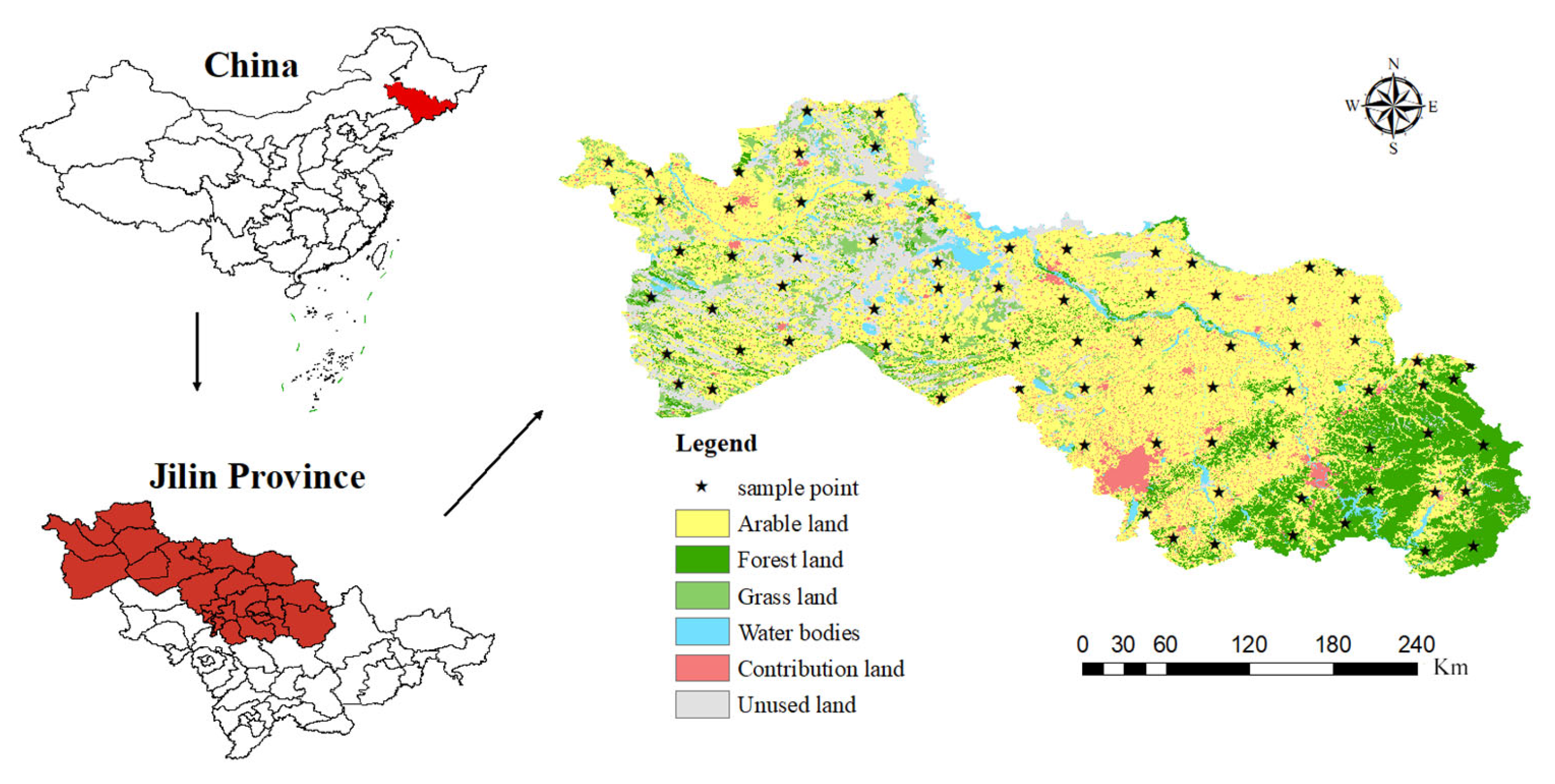
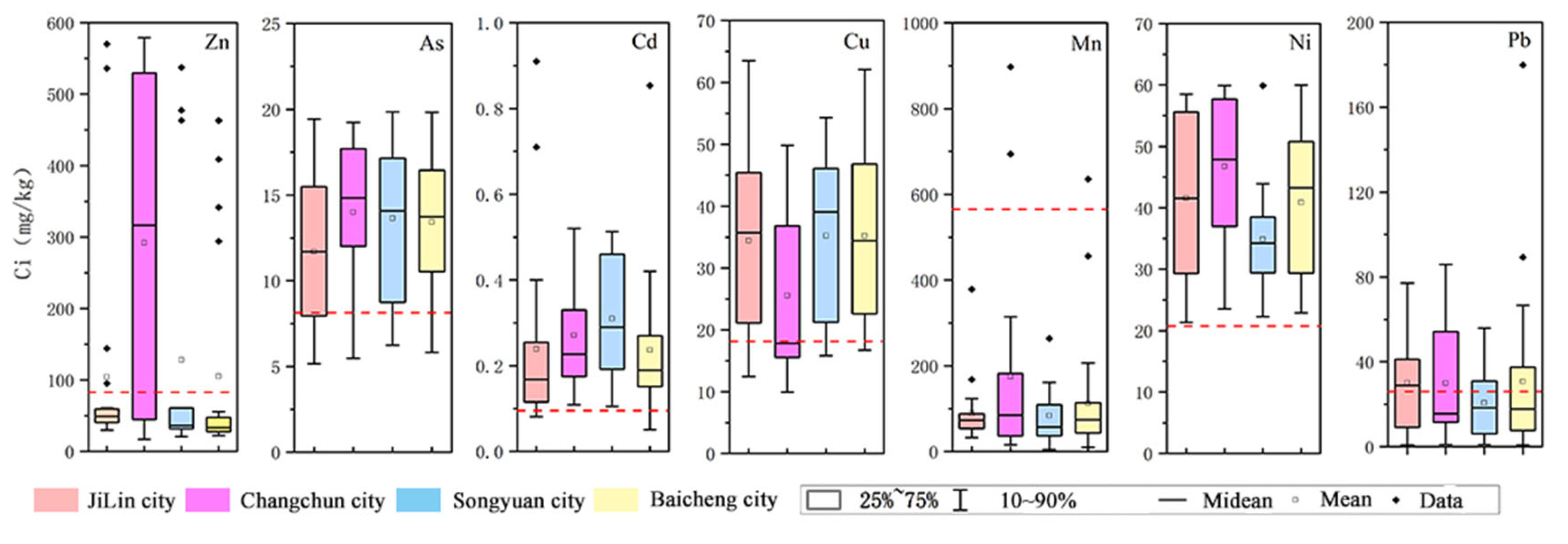
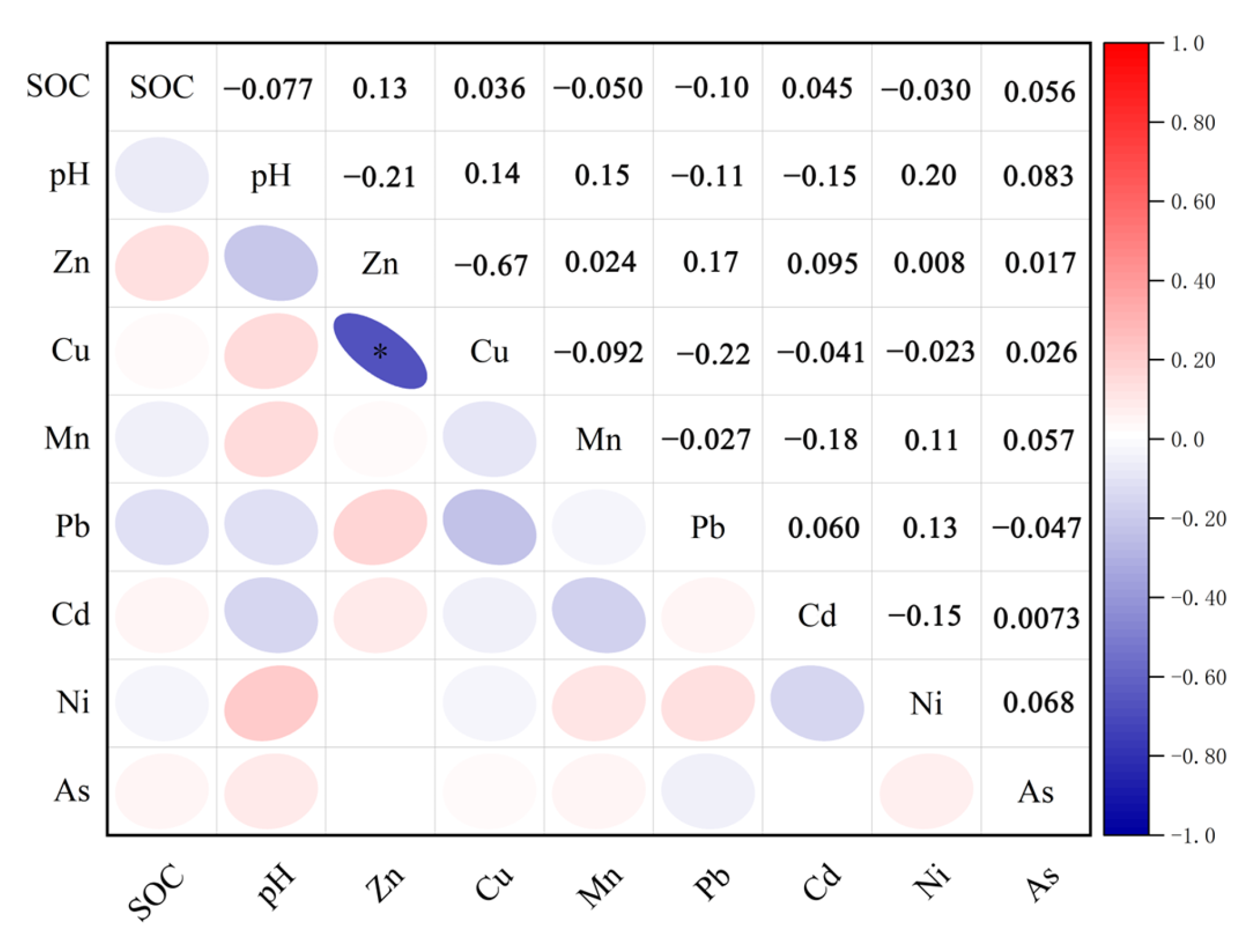


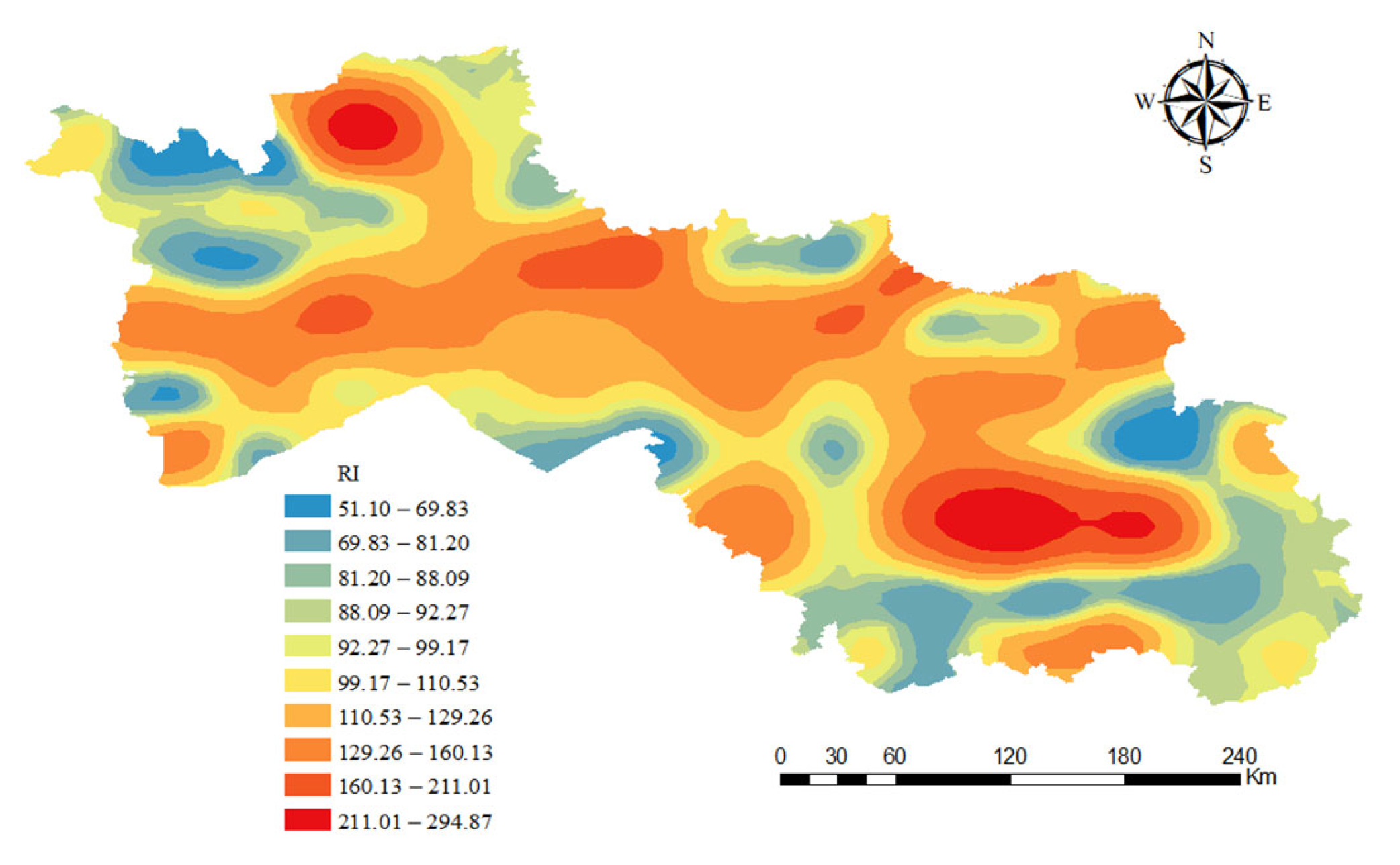
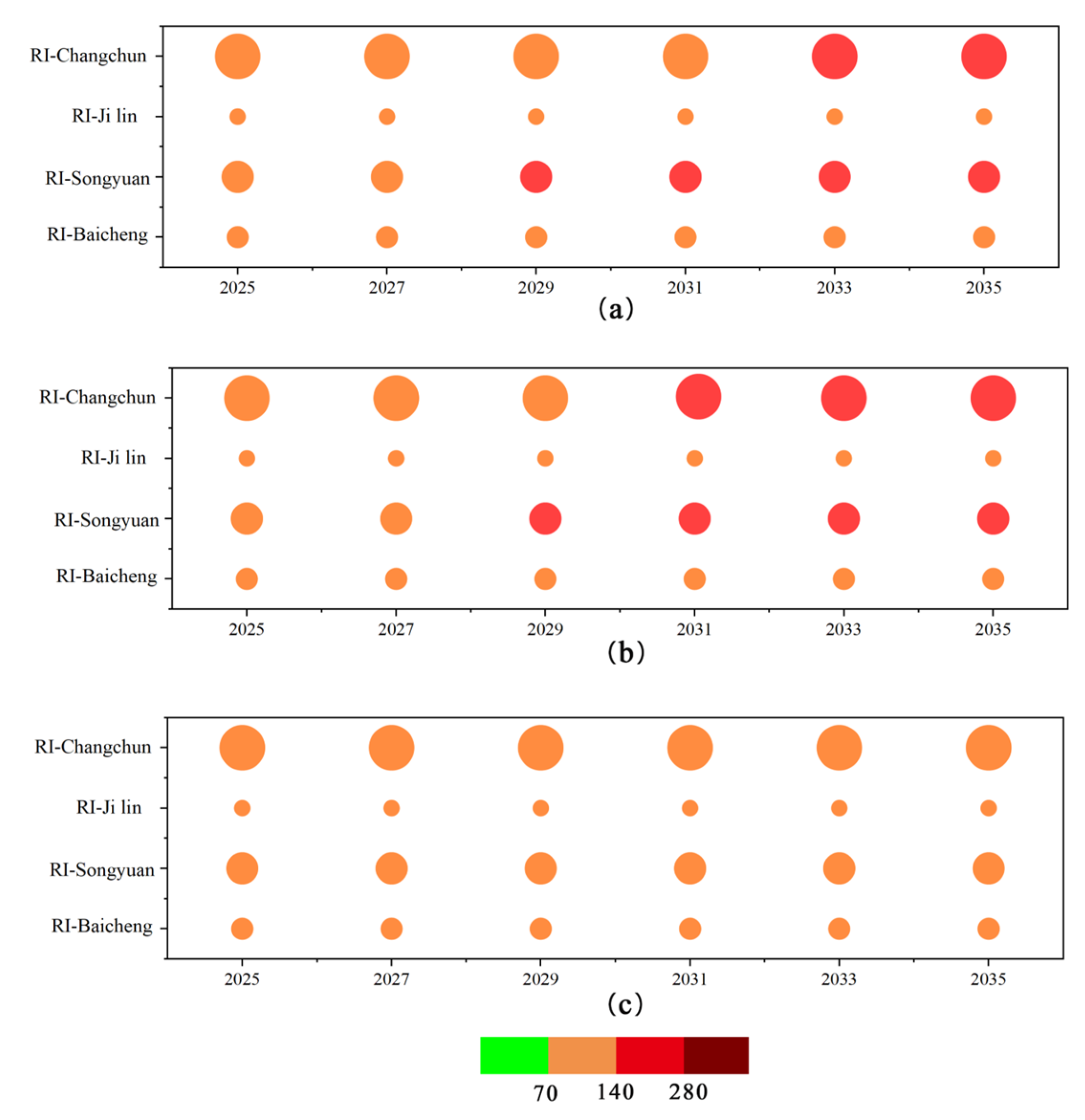
| Max | Min | Average | Standard Deviation | |
|---|---|---|---|---|
| pH | 8.25 | 5.19 | 6.93 | 0.8 |
| SOC (g/kg) | 22.99 | 15.05 | 18.92 | 2.46 |
| Principal Component Load | ||||
|---|---|---|---|---|
| PC1 | PC2 | PC3 | PC4 | |
| Zn | 0.895 | 0.035 | 0.032 | 0.036 |
| Cu | −0.902 | 0.055 | −0.085 | 0.039 |
| Mn | 0.162 | −0.737 | −0.063 | 0.131 |
| Pb | 0.258 | 0.24 | 0.719 | −0.17 |
| Cd | 0.141 | 0.745 | −0.111 | 0.141 |
| Ni | −0.094 | −0.292 | 0.762 | 0.183 |
| As | −0.0002 | 0.012 | 0.02 | 0.964 |
| Percentage of variance (%) | 24.788 | 17.782 | 16.051 | 14.751 |
| Percentage of accumulation (%) | 24.788 | 42.570 | 58.621 | 73.372 |
| Min | Max | Contribution (%) | |
|---|---|---|---|
| Zn | 0.24 | 8.08 | 1.86 |
| Cu | 3.06 | 19.55 | 8.78 |
| Mn | 0.01 | 1.56 | 0.17 |
| Pb | 0.15 | 38.96 | 5.37 |
| Cd | 14 | 249.77 | 61.89 |
| Ni | 4.92 | 13.82 | 8.27 |
| As | 6.15 | 23.69 | 13.66 |
| RI | 51.1 | 294.87 | |
Disclaimer/Publisher’s Note: The statements, opinions and data contained in all publications are solely those of the individual author(s) and contributor(s) and not of MDPI and/or the editor(s). MDPI and/or the editor(s) disclaim responsibility for any injury to people or property resulting from any ideas, methods, instructions or products referred to in the content. |
© 2025 by the authors. Licensee MDPI, Basel, Switzerland. This article is an open access article distributed under the terms and conditions of the Creative Commons Attribution (CC BY) license (https://creativecommons.org/licenses/by/4.0/).
Share and Cite
Liu, Z.; Li, J.; Chen, Y.; Zhang, F.; Feng, W. Long-Term Trends and Ecological Risks of Heavy Metal Accumulation in Cultivated Land of Songnen Plain, China. Toxics 2025, 13, 59. https://doi.org/10.3390/toxics13010059
Liu Z, Li J, Chen Y, Zhang F, Feng W. Long-Term Trends and Ecological Risks of Heavy Metal Accumulation in Cultivated Land of Songnen Plain, China. Toxics. 2025; 13(1):59. https://doi.org/10.3390/toxics13010059
Chicago/Turabian StyleLiu, Zonglai, Jinying Li, Yanan Chen, Fengjun Zhang, and Wei Feng. 2025. "Long-Term Trends and Ecological Risks of Heavy Metal Accumulation in Cultivated Land of Songnen Plain, China" Toxics 13, no. 1: 59. https://doi.org/10.3390/toxics13010059
APA StyleLiu, Z., Li, J., Chen, Y., Zhang, F., & Feng, W. (2025). Long-Term Trends and Ecological Risks of Heavy Metal Accumulation in Cultivated Land of Songnen Plain, China. Toxics, 13(1), 59. https://doi.org/10.3390/toxics13010059






